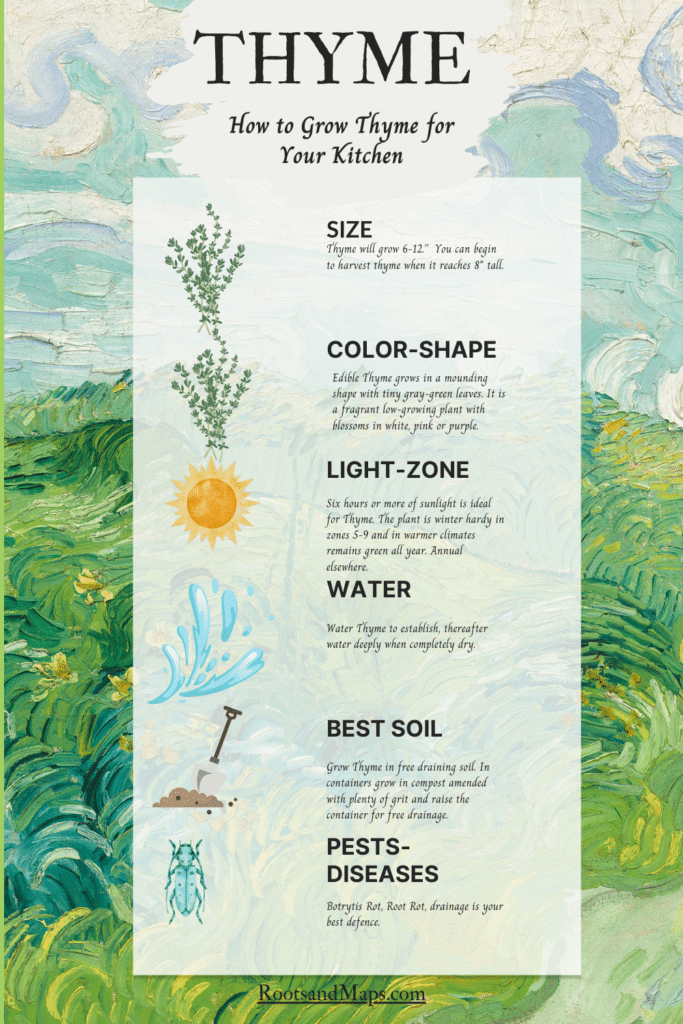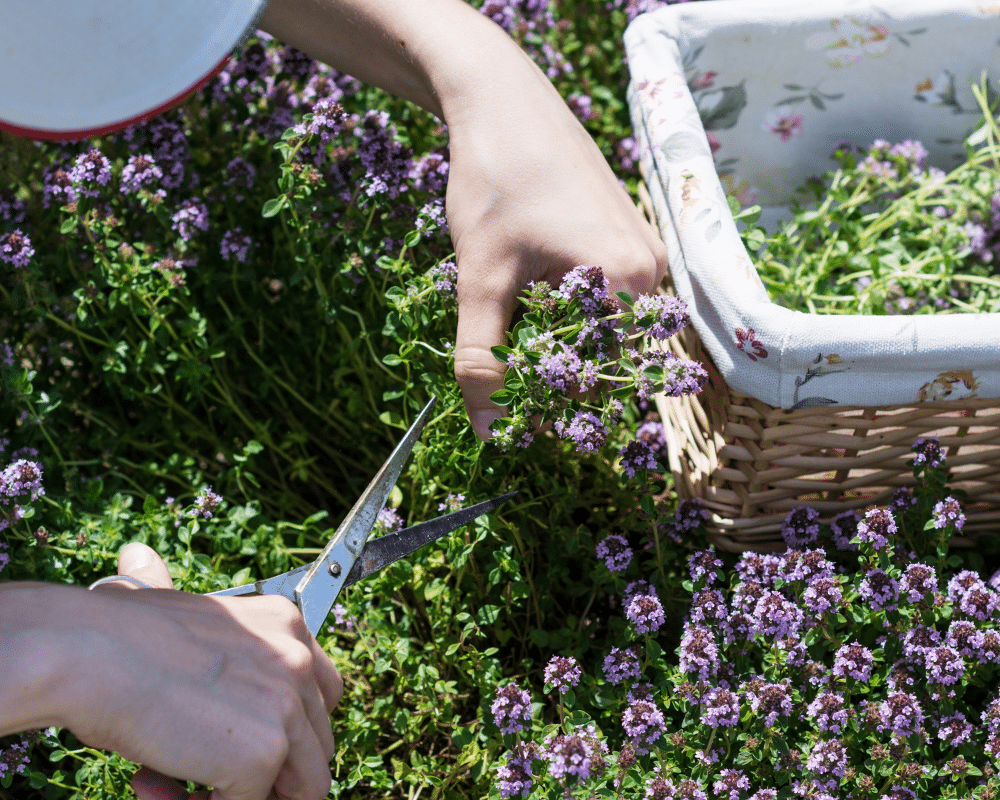What Thyme Is -Why People Love It
Thyme is a Mediterranean herb and has been grown in the garden for the kitchen for thousands of years. Its name comes from the ancient Greeks, and we think that it originates from a root word that means either perfume or courage. People have always valued the plant for its scent and flavor. Here is how we grow it in the garden for the kitchen.

Greek Thyme honey is legendary, and the small country still has the most beehives of any nation in Europe. Farmers in Spain, France, and Italy grazed their goats on wild Thyme; French cooks made it the main ingredient in Bouquet Garni and Herbes de Provence. Early settlers to America brought it with them, for cooking, a pretty scent in the garden, and to tuck in the laundry press. Thomas Jefferson was charmed by it and raised 26 varieties.

Thyme In The Kitchen

Thyme is pungent, fresh, and has a hint of clove. In the kitchen, use it both fresh or dried in items like meats, soups, salads, flavored butter, vinegar, and a pretty garnish. If you enjoy any Mediterranean foods, you need Thyme in the garden. Don’t forget the flowers in season. They garnish soups, salads, and beverages.
How To Prepare Thyme For Cooking
Thyme’s tiny, delicate, and flavor-filled leaves grow in stiff, thin but hard stems. Use the stems in bundled herb packages like bouquet garni, below. Otherwise, remove the leaves from the stems. This is the easiest way to do it.
- If you have a group of small stems, together on a main stem, separate them.
- If the stems are firm, pull the leaves, against the growth to remove from the stem’
- If the stem is fine and delicate, pull the leaves with the stem/
- If the stem is very tiny, You can simply chop the whole piece.
Make a Bouquet Garni
Tie together a little bundle of Thyme, Parsley, and Bay Leaf; you can wrap up your little bundle in cheesecloth and tie with butcher’s twine. Use this in stews, stocks, and poaching liquids. Just pull the package out when you are ready to serve.
Cooking With Thyme
Thyme can stand up to cooking, this is especially true with dried thyme, you can add it early in the cooking process. The tiny fresh leaves are delicate, add them to the soup, salads and vegetables as you serve the dish.
Measurements, often recipes say, “use a sprig”, normally this means a single stem about 5″ in length.
Lemon and Thyme, Chicken Thighs-from Food and Wine
Marcella Hazan’s FIsh With Salmoriglio Sauce-also from Food and Wine
Lemon and Thyme Lamb Chops-Allrecipes-We tend to reach for the rosemary with lamb, here is another twist.
Growing Thyme in The Garden

Planting Thyme
Plant after the ground temperature reaches 70 degrees. Use cuttings or small, young plants. Thyme requires well-drained soil. Space the plants about 9 inches apart. Read the label instructions for the variety you are planting. There are some differences among types, including the hardiness zone. You can grow it from seed. However, the seeds are difficult to germinate and take a long time to sprout.
Companion Plants For Thyme
Companion planting is placing certain plants and crops in close proximity to one another because they have properties that provide mutual benefits. These can be pest control, pollination, habitat for beneficial insects, maximizing space, and improving productivity. This link shows a unique, beneficial pairing of plants and insects.
Companion plants for Thyme
- Plant Thyme with Rosemary and Sage because they share the same drier conditions. You can put them in the same pot. Basil, for example, will require more moisture. You can plant it in the same container as parsley.
- Plant Thyme with Strawberries, Cabbage, Tomatoes, Eggplants, Broccoli and Brussels Sprouts. Thyme has aromatic qualities that repel damaging insects. It will help discourage cabbage worms, corn earworms, tomato hornworms, and flea beetles.
- Conversely, thyme will attract beneficial insects like hoverflies, which eat damaging aphids, thrips, and caterpillars.
Water and Fertilizer
Thyme wants perfect drainage. The most likely way to damage the plants is with standing water or wet soil. It readily accepts sandy and rocky soil, which is slightly alkaline, (a pH of 6-8). As an example, I saw a successful bed of thyme planted in a, no longer used children’s sandbox. The owners just added compost and soil.
Fertilize Thyme with an all-purpose 10-10-10 ratio fertilizer. Use the fertilizer at half-strength to prevent the production of too much foliage. This will dilute the strength of the plant’s oils and flavor. Water the plants well to distribute the fertilizer.
Pruning Thyme

Thyme is a thick, spreading, or mounding plant that forms mats. Prune it regularly. Pruning will prevent it from becoming woody, which will shorten its life. Pruning will prevent fungal diseases that can occur when the plant is heavily matted. Also, the trimmings are useful, and a large amount of trimmings from a heavy pruning will present an opportunity to dry a considerable amount of leaves for future use.
Prune a healthy plant in spring, again after it flowers and again in later summer, roughly 50 days after blooming.
Pruning For Harvest
For the kitchen, take about 4″ of stem closest to the plant tip. These will be tender and have the most flavor. The flowers are tasty and lovely sprinkled on soups and salads. If you are harvesting leaves to dry them, the leaves just before flowering have the most pungent oil and, therefore, flavor.
Pests And Diseases Of Thyme
The best defense against pests and diseases in the garden is, you know it, … a good offense. That means preparation and good maintenance. Healthy soil, appropriate light conditions, superior drainage, and air circulation. Good air circulation is particularly important in plants susceptible to fungal diseases and results from accurate plant distance and pruning.
Diseases To Look For
Botrytis Rot: Its appearance begins with brown spots on leaves and buds and progresses to rotting of flowers and the appearance of fuzzy gray mold. The plant must be destroyed. The treatment is primary prevention and includes cleanliness and commercial growers use fungicide prior to anticipated wet weather. In our zone 10 climate, there may be a few weeks when we have no Thyme due to humidity.
Rhizictoria (Root Rot): This disease attacks the roots of plants growing in wet soil. It is caused by a fungus and can be reduced by keeping dry soil, not watering Thyme until it is dry, and even attempting to pull back the soil to encourage drying. In our wet, humid summers we move potted herbs undercover, this appears to extend their useful lives.
How to identify the disease. Plants with root rot cannot absorb regular food and water from the soil. Look for stunting, wilting, and discolored foliage. There are chemical fungicides and biological agents available, and they do require detailed knowledge. Here is an excellent opportunity to talk with your local county Extension agent. Here is how to find it. Just enter your zip code.
Good Varieties To Choose From
French Thyme-(Thymus vulgaris)
This is a bushy plant that grows between 12-16″ tall. The foliage is small and diamond-shaped, it has the strong scent we expect from Thyme. French Thyme enhances the flavors of cheese, fish, meat, and many vegetables. French Thyme is hardy to zone 4-10.
English Thyme-(Thymus vulgaris)
This low growing perennial has gray/green leaves and tiny pink blossoms. The flavor is grassy with a little hint of both mint and clove. If a recipe doesn’t specify a type of thyme, this is most likely to be the one intended. Consider it hardy from zones 4-9-10. Some sources suggest zone 9, others to zone 10.
German Thyme-(Thymus vulgaris)
A low-growing, spreading plant, German Thyme serves as a culinary herb and a ground cover. The very tiny gray/green leaves are pungent with a taste of both mint and light lemon. Use it in meat, cheese, soups, and sauces. It is hardy from zones 5-9.
Lemon Thyme-(Thymus citriodarus)
Known for its fresh lemon scent, it enhances the flavor of many foods. Use it on fish, soups, marinades, stuffing, other seafood, and vegetables. It is small and shrub-like with lance-shaped leaves. In appearance, it resembles English Thyme, but the scent and taste are distinctive. Cultivars include Silver King, Silver Queen, Doone Valley, and Argentus. There are related cultivars with lime and orange flavor and scent. This herb is hardy from zones 7-9, note that it is less cold hardy than some others. In colder zones, you can consider it an annual.
Oregano Thyme-(Thymus vulgaris Oregano)
The leaves are small, fragrant, and tiny. They emerge light green in spring and later turn dark green. This one produces lavender flowers in early spring for about four weeks. I see it recommended for honeyed pork chops! It grows 12″ tall and is hardy in zones 5-11. (For Thyme, hardy to zone 11 is unusual.)
Caraway Thyme-(Thymus herba barona)
It does have a caraway scent and is one of the rare creeping Thyme with a smell. It has lavender blooms and is a rapacious grower. Allow it space. I see it` recommended for bread and meat, and its name refers to using Thyme to freshen meat in the Middle ages. It is hardy to zones 5-9.
Summary, Living With Thyme
Thyme has been part of our gardens for a long time and people have evolved beautiful ways to incorporate it. Local public gardens in your area may have some ideas. Here are some.
Summer Blooming Bulbs
Alliums, Lilies, and Spiderliies are planted in the same bed with Thyme and will grow through the spreading plants. This article discusses Thyme as an aromatic groundcover and suggests bulbs and perennials you may include.
Evergreens
Dwarf conifers can be combined with Thyme. This article features conifer gardening and includes Thyme to fill in some of the spaces. It may give you some ideas.
Rock Gardens With Other Plants
Rock gardens, walls, and slopes are attractive ways to include Thyme. It will cover hard-to-mow areas with poor soil. Consider Betony, Bee Balm, Sage, Pincushion Flower, and Artemesia along with Thyme.
